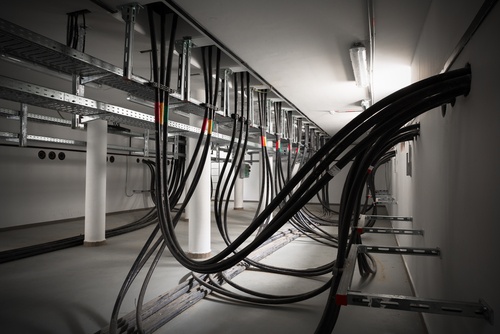Electrical Engineering Tips to Reduce Wiring Costs in Buildings

Large electrical components like backup generators, transformers and switchgear are among the most expensive elements in electrical installations. However, wiring can also have a significant cost, especially in large buildings where circuits can be several hundred feet long. Wiring costs can be reduced by minimizing the distance traveled between power supplies and loads, and also by using smaller conductors whenever possible.
Consider that wiring only represents part of the cost of electrical circuits. Unless the conductors are designed for direct exposure, they must be installed inside a raceway or conduit. Electrical installations also use fittings to accomplish several functions, and the following are some examples:
- Conduit supports. Some supports attach conduit directly to walls and other surfaces, while others hang conduit from structural elements such as beams.
- Couplings, used to connect conduit together in long circuits.
- Connectors, used to connect conduit to other elements such as distribution boards, junction boxes and equipment housings.
All these components add costs to an electrical system, and consider there is also a skilled labor cost during their installation.
Optimize the cost of your electrical installation.
Using Smaller Conductors in Electrical Design
The cost of conductors decreases along with their wire gauge size, which means that circuits can become less expensive if they use the smallest conductor size possible. Of course, there is a lower limit:
- The NFPA 70 National Electrical Code establishes minimum conductor capacities according to load current and the specific type of conductor. Using any wire gauge size below the specified capacity is against the code.
- Conductors have some electrical resistance in spite of their name, causing a gradual voltage drop along circuits. This voltage drop can be significant in long circuits, and many electrical components are damaged by undervoltage. Even if the proposed conductor has an adequate current carrying capacity, a larger size may be required to compensate voltage drop - larger conductors have less resistance per unit of length.
To use smaller conductors while still meeting the NEC, the current carried by the circuit must be reduced. A lower current also minimizes voltage drop, allowing longer circuits with no need to increase the conductor diameter.
Reduced conductor sizes also allow the use of smaller conduit, which is less expensive and easier to handle. Electrical fittings also become cheaper, since their size is determined by conduit diameter.
The cost savings from reduced conductor sizes in one circuit are relatively small. However, the cumulative effect of downsizing many circuits can remove thousands of dollars from the project budget. There are many ways to reduce the load on electrical circuits:
- Use a higher circuit voltage, when applicable. Since electrical power is the product of voltage and current, a voltage increase leads to a current decrease. For example, a load consuming 12,000 watts draws 100 amperes at 120 V, but only 50 amperes at 240 V.
- Use three-phase power for large loads. Compared with single-phase circuits, a three-phase circuit can supply the same load while using only one neutral conductor and one grounding conductor. In other words, a three-phase circuit can carry the same electrical power while reducing the total number of conductors by four (two neutral and two grounding wires).
- Avoid oversized equipment. Larger equipment draws a higher current, requiring larger conductors. The entire installation becomes more expensive as a result, and no benefits are obtained in return.
- Deploy energy efficiency measures. Energy-efficient equipment draws less current, and conductors can be sized smaller as well. If you have 20 incandescent bulbs consuming 60 watts each, the total power is 1,200 watts; on the other hand, 20 LED bulbs consuming 16 watts each only add up 320 watts.
Downsizing conductors is a viable approach in new constructions, since there is no existing installation. However, when power consumption is reduced in an existing building, electrical engineers do not recommend a circuit replacement unless the wiring is damaged. The existing conductors will end up being oversized, but they represent a cost that was already paid, while new wiring involves additional expenses.
Reducing Circuit Length with an Efficient Layout
Electrical installation costs can also be reduced by using an equipment layout that minimizes the total circuit length. The same logic used for smaller conductors applies here: a smart layout makes sense in new constructions and major renovations, but there is no point in changing an existing installation because the cost has already been assumed.

Electrical engineers can work with architects during the project design phase, to optimize the equipment layout and minimize circuit length. 3D modeling software such as Revit MEP can also be helpful, since it allows a visualization of building systems that is not possible with conventional 2D drawings.
In high-rise constructions, a simple way to reduce circuit lengths is by distributing all major electrical equipment around a vertical shaft. For example, if a separate air-handling unit is used for each level, costs can be optimized by arranging them vertically. Distribution boards can also be installed close to minimize the length of feeder circuits. Electrical engineers avoid placing large equipment far from the main power supplies, since long circuits with large conductors are the most expensive.
Smart design decisions allow energy efficiency and projects cost reductions simultaneously. Energy efficiency measures often bring additional costs, but they compensate them by lowering many expenses: electricity bills, maintenance and installation costs.

Michael Tobias
Michael Tobias, the Founding Principal of NY Engineers, currently leads a team of 150+ MEP/FP engineers and has led over 4,000 projects in the US
Join 15,000+ Fellow Architects and Contractors
Get expert engineering tips straight to your inbox. Subscribe to the NY Engineers Blog below.

